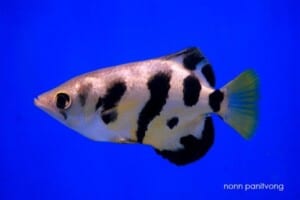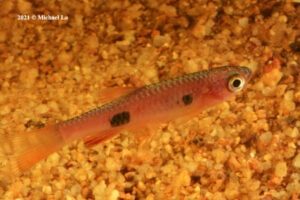Aplocheilus blockii – Green Panchax
Aplocheilus blockii was first described by Johann Paul Arnold in 1911. Their common name is”Green Panchax” or”Dwarf Panchax”. Aplocheilus blockii belongs to the family Aplocheilidae. The genus name Aplocheilus comes from Greek:”aplos” means “simple, flat” and”cheilos” means “lip.” This refers to the fish ‘ s simple lip structure. The species name blockii is a tribute to Captain Block, who was responsible for importing this fish to Germany.
There are no known synonyms, only a few that the name misspelled is recorded in scientific articles.
Description of Aplocheilus blockii
Aplocheilus blockii has an elongated body that is only moderately compressed laterally. The ground color is an iridescent yellow-green, with an iridescent blue-green belly. On the flanks are numerous reddish to golden shiny dots. The unpaired fins are lemon yellow with reddish-brown dots and spots, while the pelvic fins are orange and the pectoral fins are colorless translucent. This species of fish grows to about 5 centimeters in size.

Sexual dimorphism
Males have an iridescent yellow-green to golden yellow color with reddish to golden shiny dots on the flanks. Females , on the other hand, have a dirty yellow to greenish ground color with a dark longitudinal band and narrow transverse stripes on the caudal peduncle. Their fins are colorless, with a dark spot at the base of the dorsal fin.
Behavior and Temperament
Aplocheilus blockii inhabit the upper and middle water layers of the aquarium. Although they are predatory, they can be kept together with larger fish. The fish are not explicitly described as shy or fearless. Available sources suggest that they are best kept in a pair or with one male and several females, indicating a non-solitary lifestyle.
Life expectancy
The life expectancy of Aplocheilus blockii in the wild is not known. In an aquarium, they can live about 3 to a maximum of 5 years.
Aplocheilus blockii biotope
Aplocheilus blockii occurs naturally in Sri Lanka and southern India, particularly in the states of Goa, Kerala, Tamil Nadu and more recently Karnataka. Its distribution in certain parts of the Western Ghats mountains in India requires further confirmation.
Habitattype
This species primarily inhabits lowland habitats, often in coastal areas, with standing or slow-flowing brackish or fresh water. They show a preference for habitats with surface vegetation or overhanging cover and are often found in mangrove swamps and rice fields. The linked documents do not mention specific rivers, lakes or seas where the species occurs.
Habitat Description
The natural habitat of Aplocheilus blockii is characterized by dense vegetation of grasses and riparian plants. Thus, the water edges are vegetated. The bottom consists of a dark substrate.
Natural enemies
The documents do not mention specific natural enemies of Aplocheilus blockii. However, they are known to be predatory themselves, feeding on both aquatic and terrestrial invertebrates.
Climate
The documents do not explicitly specify the climate, but since they live in lowland habitats in Sri Lanka and southern India, we can assume that they live in a tropical climate, possibly with seasonal floods or droughts. Their presence in rice fields suggests a connection with seasonal water levels.

Diet
Diet in the wild
Aplocheilus blockii is a surface dweller and predatory. In the wild, it feeds on both aquatic and terrestrial invertebrates. The exact composition of its diet is not fully documented, but it probably includes small insects, larvae and other small aquatic animals.
Diet in the aquarium
In the aquarium, Aplocheilus blockii accepts dried food, but it is essential to regularly offer them small amounts of live or frozen food. Suitable options include: mosquito larvae, aquatic woodlice, artemia, daphnia and chironomid larvae (larvae of the dancing midge). It is important to provide a varied diet to ensure optimal health. Although they accept dry food, live food is essential for their well-being. Documents suggest that they may eat their own young, so it is important to raise the young separately .
The Aquarium
For one pair of Aplocheilus blockii, an aquarium with a minimum basic size of 30×30 cm or equivalent volume is recommended. Multiple pairs require a considerably larger aquarium. The decoration should include dense edge planting and plenty of floating plants on the surface. A dark bottom is desirable, for example sand or other dark substrate. Whimsical driftwood pieces can serve as decoration.
Water conditions are not very important with this species. They thrive in temperatures between 20 and 28°C. The pH may be between 6.0 and 8.0. For breeding, a somewhat harder and alkaline water is better suited.
Compatibility with other fish
Aplocheilus blockii is predatory, but can be kept with larger fish. However, it is advisable to keep them with conspecifics in a pair or with one male and several females, and to consider their predatory nature when choosing co-inhabitants. It is important to prevent them from eating their own young. Experiences of others suggest that they are not suitable for a community aquarium with very peaceful fish. Thus, careful selection of co-inhabitants is essential.

Breeding Aplocheilus blockii
Breeding is not difficult and can take place in both community aquariums and separate breeding aquariums. In community aquariums, a temperature increase to about 28°C is necessary to encourage reproduction. If a separate breeding aquarium is used, size is not really important, but it should provide enough space for a pair or harem (one male with several females). The water quality should be moderately hard and alkaline, with a temperature of 24-27°C.
Conditioning the fish for breeding includes offering a varied diet of live foods, such as mosquito larvae, aquatic woodlice, artemia, daphnia and chironomid larvae (dancing midges). It is important to raise the young separately, as the parents may eat their own offspring.
Spawn takes place by depositing eggs in woolly spawning mops, fine-leaved plants, mosses (such as Java moss) or filamentous algae. The eggs have a firm shell. After laying, you can remove the eggs and transfer them to a rearing aquarium.
The incubation period is 10-15 days, and the young initially require infusoria as food until they are large enough to eat artemia nauplii, microworms, etc.
Details about Aplocheilus blockii
Some additional details about Aplocheilus blockii not covered in previous chapters:
- Euryhaline nature: The species is euryhaline, which means it can live in both fresh and brackish water . This is relevant to aquarium management, as light salinity can potentially be beneficial.
- Sensitivity: The species is sensitive to oodinium and copper sulfate medication. This is essential information for disease management.
- Breedingdifficulties: Although breeding is not considered difficult, problems with low egg production and low survival rate of eggs and young are reported. It is important to closely monitor water parameters and separate the young from the parents immediately after hatching.
- Variation in sex ratio: The sex ratio in breeding attempts can vary, with sometimes a preponderance of males or females. The cause of this cannot be clearly traced.
- Food: Although they accept dry food, live food is essential for their well-being. A varied diet is important for optimal health.
- Water hardness: Water hardness should be moderately hard and alkaline for reproduction. Too soft water is not suitable for the eggs.
- Temperature: The optimum temperature is between 24-27°C, but an increase to about 28°C can stimulate reproduction.
This additional information provides a more complete picture of the specific needs and characteristics of Aplocheilus blockii in both wild and aquarium environments.

Conclusion
Aplocheilus blockii, the Dwarf Panthax, is a relatively small, attractive fish with an interesting combination of characteristics. Although breeding is not extremely difficult, successful reproduction requires attention to water parameters (moderately hard and alkaline water), a varied diet with live food, and immediately separating the young from the parents to prevent cannibalism.
The species is suitable for both beginners and advanced aquarists, but requires a basic understanding of aquarium management. Their predatory nature and susceptibility to certain diseases and medications require careful selection of co-inhabitants and a proactive approach to water quality. Their euryhaline nature does offer flexibility in water parameters. Overall, it is a fascinating species to keep, but requires a bit of attention and knowledge.
Video
Author
John de Lange
Copyright images









